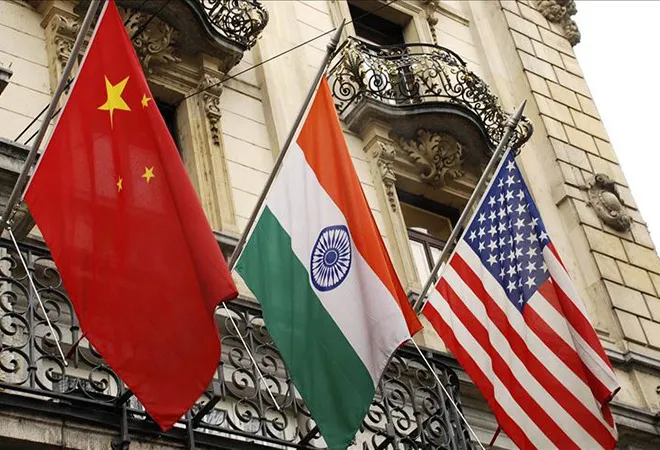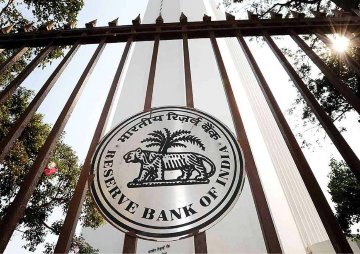
The Cold War 2.0 between the US and China that is unfolding quite rapidly both on India’s west and on her east offers a stark choice to her. India can either choose to be the fulcrum in this war, and leverage that position to secure herself strategically and economically; or India can keep latching on to the hoary hoax of cultural, historical and civilisational links, and continue the strategic self-deception of unlikely ‘friendly and good neighbourly relations’ and uncertain economic benefits, to adopt a position of neutrality (or if you will, Non-Alignment 2.0) and end up risking not just her security and economy, but also her very future. At a time when the world is again on the cusp of entering new alignments, India must choose her side. Because if she doesn’t, India will end up being squeezed, both from her east and west. Unlike Cold War 1.0 which was fought primarily in a distant theatre and only its denouement – Afghanistan – occurred in India’s neighbourhood, the theatre of Cold War 2.0 finds India in the very centre of the struggle for how the world will run in the 21
st Century.
Unlike Cold War 1.0 which was fought primarily in a distant theatre and only its denouement – Afghanistan – occurred in India’s neighbourhood, the theatre of Cold War 2.0 finds India in the very centre of the struggle for how the world will run in the 21st Century
Over the last couple of years, the US-China relationship has been going into a tailspin. In January 2018, the National Defence Strategy of the US had clearly identified
“inter-state strategic competition” – read China and Russia – as the ”primary concern” in US national security. A few months later, the first shots were fired in the
trade war between the US and China, that has since escalated. The spectre of a new Cold War had already been looming large when the Covid-19 pandemic hit the world, and accelerated the process. China’s aggressive ‘wolf-warrior’ diplomacy and opening of multiple fronts – both security and economic – against Australia, Canada, Hong Kong, Japan, Taiwan, India, Vietnam hardly helped matters and led to attitudes hardening all around.
The US was already signalling that it wasn’t going to give a walkover to the Chinese in India’s east.
Restrictions were imposed on Chinese companies and students, Chinese officials were sanctioned for human rights violations in
Xinjiang, and in a show of force,
two carrier strike groups were despatched to South China Sea to hold exercises. Strong statements by both the Secretary of State
Mike Pompeo and the White House Chief of Staff
Mark Meadows left no doubt over the direction in which things were headed.
Even as things were heating up on India’s east, a bombshell of sorts was dropped with the news of a mammoth
security and economic deal between Iran and China. Within a few days, another piece of news further muddied India's strategic environment in its west – Iran ousted India from a
rail project to link the Chabahar port to Zahedan on the Afghan-Iran border. The Chinese presence in Pakistan, including its potential naval bases in and around Gwadar, was already a matter of serious strategic concern to India. With the Chinese doubling down on taking their relations with Iran to the next level – the China-Iran deal is virtually another China-Pakistan Economic Corridor (CPEC) like arrangement and like in the case of Pakistan, will eventually transform Iran into a virtual satellite state of China – the strategic implications for India are quite deadly. In short, the Iran deal completes India’s encirclement by China.
With the Chinese doubling down on taking their relations with Iran to the next level – the China-Iran deal is virtually another China-Pakistan Economic Corridor (CPEC) like arrangement
The immediate impact of this deal will of course be felt on India’s outreach to Afghanistan. Iran offered an alternate route for India to access Afghanistan, and even Central Asia. With the US already all set to abandon Afghanistan, it means that India’s options there are going to be severely curtailed. With Iran likely to play the China game (read Pakistan and China game), India’s access to Afghanistan will be limited to the air route. The limitations of that in terms of not just trade and economic assistance but also military assistance are self-evident. Effectively, it means that the door is starting to shut on India in Afghanistan. The Chinese are in any case working through Pakistan in Afghanistan, and by roping in the Iranians, and given their influence in Central Asia and with the Russians, it is pretty much slam-dunk as far as Afghanistan is concerned. Already the Chinese have made a renewed push to play a bigger role in Afghanistan and one indication of this came from the recent
Afghanistan-Pakistan-China trilateral.
More worrying is the imminent possibility of the emergence of a new axis of countries with the acronym
PRIC (no pun intended) – Pakistan, Russia, Iran and China. The PRICs alliance has for long been a dream of Pakistani strategists, and it now seems far more possible, even imminent, than when the idea of such an axis was first floated. While originally this alliance was aimed at only Afghanistan, its potential as a challenger to the existing world order under Chinese leadership now goes far beyond Afghanistan. At the very least, such an axis completely demolishes India's strategic environment to her west and endangers her economic, energy, political and territorial security.
Iran has of course done what it thinks best serves its interest. Having been pushed to the very edge by the US, Iran had probably no option but to accept the life-line thrown by China. The Chinese had in 2016 signed a flurry of agreements during the visit of Xi Jinping to Tehran. At the time an ambitious target of
raising bilateral trade to $600 billion in ten years was set. But with the US re-imposing sanctions on Iran, this grand plan seemed to have been put on the backburner by the Chinese. If now an even grander plan has been unveiled, it is because the Chinese calculate that they can take on the Americans and their still inchoate and somewhat fuzzy plans to pushback against Chinese expansionism.
Iran has of course done what it thinks best serves its interest. Having been pushed to the very edge by the US, Iran had probably no option but to accept the life-line thrown by China
With the Chinese openly defying the US and making a bold power play in the Middle-East (where until now the US has held virtually unchallenged sway), the US red-line was crossed. The Americans were quick to strike back in China's proverbial backyard. After years of dillydallying over Chinese attempts to convert the South China Sea into China’s personal lake, the US has finally taken a position on this issue. Rejecting China’s maritime claims in the South China Sea, the
US has declared that “Beijing’s claims to offshore resources across most of the South China Sea are completely unlawful, as is its campaign of bullying to control them” and added that “the world will not allow Beijing to treat the South China Sea as its maritime empire”. The Chinese were quick to react and in a
statement the Chinese embassy in Washington accused the US of trying to “sow discord between China and other littoral countries”. The statement went on to say that the US was “flexing muscle, stirring up tension, and inciting confrontation in the region”.
Clearly, the gloves are coming off, on both sides. Going forward, tensions are only going to rise, even more so because of the new alignments that are taking place. Many of the countries sitting on the fence will soon have to decide which side they throw in their lot with. For India, the crunch time is coming. For years every country in the world, including India and the US, had been in denial about the threat that a totalitarian and expansionist China poses to the world order. In ignoring China's rise, they were practically sleep-walking towards an unmitigated disaster. But thanks to Chinese aggressive expansionism, India appears to have been rudely woken up from its slumber. So too the US, which has suddenly realised that China’s rise is neither benign nor peaceful.
For many years, US officials have been quite candid in telling their Indian interlocutors that while there is 95% strategic convergence between India and US east of India, there is only 5% west of India. The main sticking points were of course Iran, Afghanistan and Pakistan. Circumstances and choices made by others have now conspired to increase the convergence west of India to at least 50%, if not more. With Iran joining the Chinese camp, it will be that much easier for India to align her interests with the US. Add to this the imminent possibility that India could end up marginalised in Afghanistan because of extremely restricted access, another point of some divergence between US and India gets resolved. With Afghanistan out of the equation, the Pakistani problem can also be addressed more easily. Post withdrawal, Pakistan's utility for the West will take a tumble. Add to this the fact that Pakistan is now a virtual vassal of China against whom the new alignments will be made, and Pakistan will no longer remain the sticking point it has been in the last so many decades.
With Iran joining the Chinese camp, it will be that much easier for India to align her interests with the US. Add to this the imminent possibility that India could end up marginalised in Afghanistan because of extremely restricted access, another point of some divergence between US and India gets resolved
In the east of India, with the expanding Chinese footprint in India’s neighbourhood – an openly hostile Nepal government is just one example – India’s strategic challenges are only increasing. It was bad enough that India had to factor in a two-front war because of the China-Pakistan collusion. Now, there is the possibility of other fronts also opening up. India therefore needs to break through the strategic encirclement by aligning more closely with the US and allies. This was a decision India had been avoiding for the longest. But the Chinese hostility and over-reach, coupled with the moves that other countries in region have made, India can now shed the strategic shibboleths of the past that prevented her from taking sides.
India needs to break through the strategic encirclement by aligning more closely with the US and allies. This was a decision India had been avoiding for the longest. But the Chinese hostility and over-reach, coupled with the moves that other countries in region have made, India can now shed the strategic shibboleths of the past that prevented her from taking sides
Given that India is sitting in the middle of the new Cold War which is unfolding all around it, New Delhi is the natural fulcrum of this new struggle for deciding the future of the world. If India plays her cards smartly, she stands to gain the most; on the other hand, if India remains ambivalent, and tries to hedge her bets, then she very well could end up being the biggest loser. In the emerging scenario, neutrality is probably the worst option for India. There is no way India can go with China because that is the path of servitude. With the US and its allies, it will be a partnership, albeit a somewhat unequal one. Because of the sheer power differential, it is a given that the US will be the first among equals. Even so, the benefits in terms of trade and security from joining a US-led alliance will be far greater and more equitable than those that will accrue to India if she tied up with a exploitative, extractive, egotistical and expansionist China.
The views expressed above belong to the author(s). ORF research and analyses now available on Telegram! Click here to access our curated content — blogs, longforms and interviews.



 The Cold War 2.0 between the US and China that is unfolding quite rapidly both on India’s west and on her east offers a stark choice to her. India can either choose to be the fulcrum in this war, and leverage that position to secure herself strategically and economically; or India can keep latching on to the hoary hoax of cultural, historical and civilisational links, and continue the strategic self-deception of unlikely ‘friendly and good neighbourly relations’ and uncertain economic benefits, to adopt a position of neutrality (or if you will, Non-Alignment 2.0) and end up risking not just her security and economy, but also her very future. At a time when the world is again on the cusp of entering new alignments, India must choose her side. Because if she doesn’t, India will end up being squeezed, both from her east and west. Unlike Cold War 1.0 which was fought primarily in a distant theatre and only its denouement – Afghanistan – occurred in India’s neighbourhood, the theatre of Cold War 2.0 finds India in the very centre of the struggle for how the world will run in the 21st Century.
The Cold War 2.0 between the US and China that is unfolding quite rapidly both on India’s west and on her east offers a stark choice to her. India can either choose to be the fulcrum in this war, and leverage that position to secure herself strategically and economically; or India can keep latching on to the hoary hoax of cultural, historical and civilisational links, and continue the strategic self-deception of unlikely ‘friendly and good neighbourly relations’ and uncertain economic benefits, to adopt a position of neutrality (or if you will, Non-Alignment 2.0) and end up risking not just her security and economy, but also her very future. At a time when the world is again on the cusp of entering new alignments, India must choose her side. Because if she doesn’t, India will end up being squeezed, both from her east and west. Unlike Cold War 1.0 which was fought primarily in a distant theatre and only its denouement – Afghanistan – occurred in India’s neighbourhood, the theatre of Cold War 2.0 finds India in the very centre of the struggle for how the world will run in the 21st Century.
 PREV
PREV


